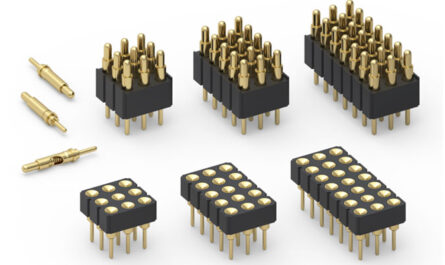Non-destructive testing (NDT) refers to a wide group of analysis techniques used in science and industry to evaluate the properties of a material, component or system without causing damage. It is a type of inspection method that is used to evaluate the properties of a material, component or system in a way that does not cause damage. Some common NDT methods include ultrasonic testing, radiography, liquid penetrant testing, magnetic particle testing, eddy-current testing and visual testing.
Ultrasonic Testing
Ultrasonic testing is one of the most common and widely used Non-Destructive Testing methods. It uses high-frequency sound waves to conduct examinations and make measurements. In ultrasonic testing, a transducer is used to send high-frequency sound waves into the material that is being tested. Then another transducer receives the signal that is reflected back from the material. The process is similar to echo sounding. Flaws and changes in the material structure or composition cause changes in the transmission of the ultrasound through the material. These changes are then detected and analyzed by the receiving transducer and processing equipment. Areas of discontinuity or change are identified and evaluated. Ultrasonic testing works on a wide variety of materials, such as metals, composites and ceramics.
Radiographic Testing
Radiographic testing uses either X-rays or gamma rays to produce images of the internal structure or composition of an object. The object is exposed to radiation from an x-ray source and the pattern of radiation that passes through is recorded on a detector. The x-ray image produced highlights any density variations within the component. Discontinuities such as seams, shrinkage, porosity and cracking may be revealed in the image. Radiography provides internal images similar to medical x-rays. It is commonly used in welding inspection and for tubing/piping applications. Radiographic testing is highly reliable but the equipment and safety precautions required for use make it more complex than other Non-Destructive Testing methods.
Liquid Penetrant Testing
Liquid penetrant testing is a widely used technique to detect surface-breaking defects in non-porous materials. It depends on capillary action and the ability of certain penetrant liquids to flow into surface-opening defects. In this technique, a penetrant liquid is applied to the surface of the part being inspected. The liquid flows into surface-opening defects by capillary action. After a dwell time, excess penetrant is removed from the surface. A developer is then applied which draws the penetrant from the defects to the surface by capillary action where it is visible. The indications are then evaluated. This process is very good for inspecting castings and welds for surface-breaking defects.
Magnetic Particle Testing
Magnetic particle testing is used to detect discontinuities or imperfections in ferromagnetic materials. It depends on the principle that any flaw or discontinuity in a ferromagnetic material provides a leakage field from the magnetic lines of flux. In this method, the test part is first magnetized, usually by passing electric current through it. The magnetic field lines passing through it will be distorted at the place of any such imperfection. Iron particles or a wet magnetic ink is applied on the surface which gets attracted to these regions of flux leakage and indicates the presence of flaws. This helps in detecting hard-to-find surface or near-surface flaws in components like gears, shafts and welds.
Eddy Current Testing
Eddy current testing utilizes the principles of electromagnetic induction to detect surface and near surface flaws. An alternating current is passed through a coil called a probe which produces a magnetic field. This field induces eddy currents in the part being tested. Interaction between eddy currents and the applied magnetic field depends on material conductivity. Any flaws or changes in material properties causes disturbances in the eddy currents. This allows evaluation of properties like conductivity, thickness and dimensional characteristics. Eddy current testing is an effective technique for inspecting tubing, heat exchanger tubing and aircraft parts for cracks and corrosion.
Visual Testing
Visual testing or visual inspection is the simplest NDT technique and involves using the human eye, sometimes aided by optical or low magnification instruments, to detect surface defects and discontinuities. Proper illumination is important for the detection of surface flaws and roughness in components. Visual testing is used extensively as a primary screening method for dimensions, coating thickness, welding imperfections and fit-up conditions. It continues to be widely utilized for incoming, in-process and final inspections by NDT technicians across industries. Although subjective, it remains a very useful and cost-effective method when specificity is not required.
Applications of Non-Destructive Testing
NDT techniques help ensure quality, reliability and safety across a variety of industries. Some major applications include:
– Aerospace – Detection and monitoring of cracks/defects in aircraft parts and structures. Important for meeting strict safety norms.
– Power generation – Inspection of boilers, pressure vessels, piping systems and turbines in nuclear and conventional power plants. Criticality here requires extensive NDT.
– Oil and gas – Pipeline integrity testing and inspection of offshore structures for corrosion, cracks, manufacturing issues. Routine evaluations uphold safety in hazardous environments.
– Manufacturing – Quality control of castings and welds. In-line inspections prevent defects from moving downstream. Key for automotive and heavy equipment manufacturing.
– Construction – Assessment of structural weaknesses in bridges, buildings, tunnels before/during/after construction using various NDT approaches.
– Welding inspection – Identifying porosity, lack of fusion and cracks in welds across all industrial domains mentioned above. Critical to functioning of welded joints.
The Benefits of Non-Destructive Testing
The main benefits of NDT include safety assurance, quality control, cost-effectiveness and reliability optimization:
– Safety: NDT helps detect critical flaws in structures and components before failure occurs, preventing accidents and loss of lives.
– Quality: Quality inspection using NDT methods aids detection of manufacturing flaws and defects early in the process, reducing defects and reworks.
– Costs: NDT helps reduce costs associated with unplanned downtime, repairs and replacements if defects lead to failures at a later stage.
– Reliability: Periodic NDT inspections assess material degradation issues and allow planned maintenance/repairs, maximizing service life and operational reliability of critical assets.
– Standards compliance: Various industries rely on NDT to comply with statutory quality, safety and reliability standards imposed by regulations and certifying authorities.
Non-destructive testing plays a vital role across modern industries by enabling inspection of materials and systems without impairing their future usefulness. The application of various NDT techniques as an integral part of quality assurance programs helps proactively manage risks, ensure regulatory compliance and optimize safety, performance as well as costs over the long run. Advancements in NDT technologies will further expand their capabilities and make.
*Note:
1. Source: Coherent Market Insights, Public sources, Desk research
2. We have leveraged AI tools to mine information and compile it




